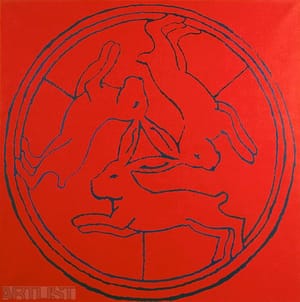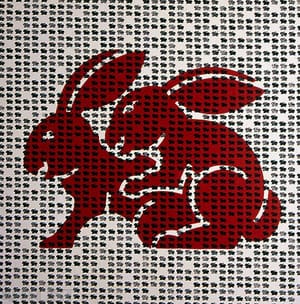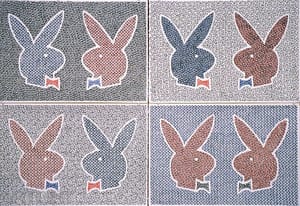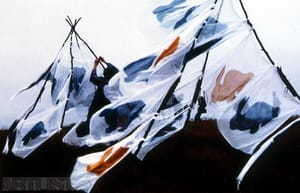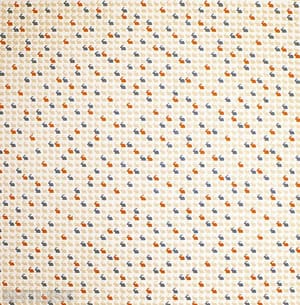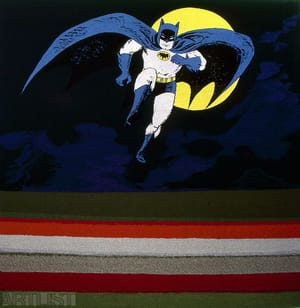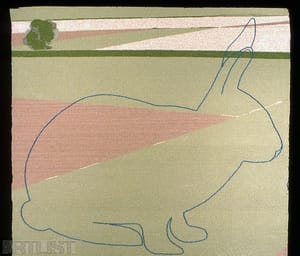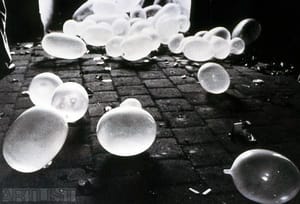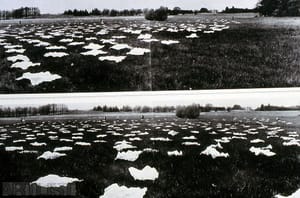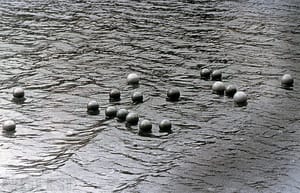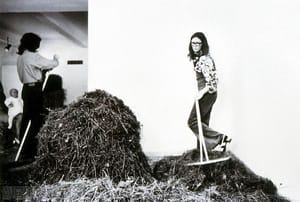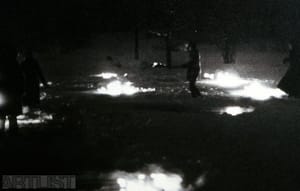- First Name
- Zorka
- Surname
- Ságlová
- Born
- 1942
- Birth place
- Humpolec
- Place of work
- Praha
- Died
- 2003
- Lived and worked in
- Praha
- CSU Library
- ↳ Find in the catalogue
About artist
Between 1961-1966 she studied under professor A. Kybal in the textile studio at the Artistic-Industrial High School (VŠUP) in Prague. During the first half of the 1960s she focused on constructive, geometric painting, serial paintings of structures composed of tiny geometric elements. In her earlier works she applied a structural principle of atlas bonds to paintings and objects. The point structure of her painting series from the 1960s is a technique she would later return to in the 1980s using rabbit motifs. This structure comes directly from methods for drawing textile matrices. She followed, in this way, the stream of Czech geometric abstraction, which she presented at the exhibits, Constructive Tendency / Konstruktivní tendence (1966) or New Sensitivity / Nová citlivost (1968). She developed constructive geometric painting at the end of the 1960s in the space of relief images and geometric objects. In the late 1960s / early 1970s she adapted this to the open landscape in land art events with the music group, Plastic People, and artistic circles associated with the Křížovnická Škola group. In 1969 a key exhibit, Hay-Straw / Seno-sláma (as part of the show, Somewhere something / Někde něco by B. and J. Kolář) took place in the Špálová Gallery. Both the media and most of the creative art scene criticised this work for its „depravity.“
During the period between 1969 – 1972 she did indeed realise several events in out-of-gallery spaces and in the open landscape. Of course she had otherwise been prohibited from public acts for a long time. She addressed paraphrasing and quotes in the iconography of medieval tapestries. She also discovered the rabbit motif on these old tapestries. This became her guide and the main theme of her creations. She explores the rabbit as a carrier of diverse historic and cultural contexts, but at the same time she plays with its forms as a would-be, beloved, domestic animal. At the start of the 1980s a series of pictures came into being, in which the painted outline of the rabbit is repeated in a serial structure, whose beginning point is once again atlas bonds. The structure develops most often from rotating rabbits of two different colours. Her several-year-long work on painted structures with many hundreds of rabbit figures ceded its place to dynamic stamp pictures. In these the number of rabbits floated in circular and spiral formations from the centre to the edges. She created other drawings, on which she worked with a live rabbit, using colour footprints from rabbit’s feet. The artist combined these with drawing of rabbit silhouettes, using the help of written texts related thematically to the rabbit.
Photocopied archaeological and scientific drawings or ceramic signs became a further material she would work with. The clever manipulation of individual signs or parts (thereof) led again to geometric structures. This time, however, they were conditioned on the internal activity or the aesthetic or emotional experience. This method stemmed form the principle of programming; she showed off photographic or reproductive gestures in ritual painting. By uncovering symbols of older cultures and in combining them, she demonstrated cosmic forces and natural law, interpreted in characteristic compositions in other works based on the symbolism of the yin and yang principles. Since the 1990s she has focused on the conceptual research of the rabbit’s mythological meaning, on Chinese mythological symbols and shape elements found in archaeological drawings.
- Author of the annotation
- Věra Jirousová
CV
1960-1966 Academy of Arts, Architecture and Design in Prague
Exhibitions
- Solo exhibitions
-
2006
Veletržní palác. Národní galerie v Praze.
Pražákův palác. Moravská galerie v Brně.
2002
Dům umění, České Budějovice. Obrazy a asambláže.
Galerie Millenium, Praha.
2001
Dům umění města Brna.
2000
Galerie Via Art, Praha.
1999
Galerie Na bidýlku, Brno.
1998
Galerie Genia Loci, Praha.
1997
Galerie Via Art, Praha.
1995
Zorka Ságlová 1965 - 1995, Galerie Výtvarného umění Litoměřice, katalog
1994
Krajiny - zátiší, Galerie MXM
Sokolská 26, Ostrava, Centrum kultury a vzdělávání
1993
Galerie Coupole, Neu-Isenburg, Německo.
1992
Králíci, (s Franciskou Krammel) . Alberndorf i. P., Rakousko;
Galerie MXM, Praha;
Retrospektiva (1965-1992). Galerie Stará radnice, Brno (J. Valoch);
Tapiserie a kresby, Sovinec.
1990
Galerie Coupole, Neu-Isenburg, SRN;
Opatov, Praha;
Ústřední kulturní dům železničářů, Praha (I. Janoušek);
GU Karlovy Vary (J. aj. Ševčíkovi, V. Jirousová).
1989
Ústav makromolekulární chemie ČSAV Praha.
1988
Realistické divadlo, Praha;
11 045 králíků, Drogerie Zlevněné zboží, Brno, videodokumentace Jan Sagl
1969
Seno-sláma (část výstavy Někde něco J. Koláře a B. Kolářové). Galerie V. Špály, Praha.
- Group exhibitions not included in ARTLIST.
-
2006
V závěsu avantgardy? České výtvarné umění 1956-1978 ze sbírek Muzea umění Olomouc. Muzeum moderního umění, Olomouc.
2004
Blízká vzdálenost/Közeli távolság/Proximate Distance. Steny Uštván Király Múzemu, Székesfehérvát, Maďarsko.
2003-2004
Ejhle světlo. MG Brno.
2003
Struktura…Galerie U Bílého jednorožce, Klatovy;
Pražské bienále 1. NG Praha.
2000
Dva konce století. ČMVU, Praha.
1997
Actual textile art. GVU, Hodonín.
1996-1997
Umění zastaveného času. Brno, Cheb, Praha.
1996, 1999, 2002
I.-III. Nový zlínský salon. Zlín.
1995
Na hranici znaku. Kutná Hora.
1993
Mona Lisa. Galerie Mladých, Brno;
Příběhy bez konce. Dům umění m. Brna;
Sdružení pražských malířů. Mánes, Praha;
Mezinárodní trienále textilního umění. Tournai, Belgie.
1992
Drogerie Zlevněné zboží 1986-1989, Rennes, Francie;
Kolumbovo vejce. Galerie Behémót, Praha;
Minisalon. Nová síň, Praha;
Šedá cihla 35/1992. Galerie Klatovy-Klenová.
1991
Galerie Coupole, Neu-Isenburg, Německo;
Galerie MXM, Praha;
Umění akce. Mánes, Praha;
Alternativy české a slovenské tapiserie. Dům umění, Brno;
Art Jonction International. Nice, Francie.
1990
Současná česká malba. Walker Jill Art Center, Soul, Korea;
Nové cesty kresby a grafiky. Palác kultury, Praha;
Pocta Andymu Warholovi. Muzeum Andyho Warhola, Medzilaborce, SR.
1989
Nová grafika. Výstavní síň Umění-knihy, Vodičkova, Praha;
Tschechische Malerei Heute. Esslingen, SRN;
Razítkové umění-Stamp Art. Institut průmyslového designu, Praha.
1988
Salón pražských výtvarných umělců. Praha; Dny otevřeného dialogu. Vysokoškolský klub, Brno.
1986
Textilní výtvarníci k súčasnosti. Slovenské národné muzeum, Bratislava.
1982
Czechoslovac imparmuvészet. Galéria V, Budapešť, Maďarsko.
1981
Mezinárodní výstava textilních miniatur, Jindřichův Hradec, Galerie "d" Praha
Návraty k přírodě. Salon fotografia, Bělehrad
1980
3. mezinárodní bienále textilních miniatur. Savaria Muzeum, Szombathely, Maďarsko.
1979
Krajinná inspirace. Jindřichův Hradec, Galerie d, Praha;
1973
8. biennale de Paris;
Omaha Flow Systems. The Joslyn Art Museum, Omaha, Nebraska, USA;
De Beneville Pines. Angelus Oaks, Kalifornie, USA.
1971
Interventi di land art. Universitá degli studi, Lecce, Itálie.
1970
Výstava Mladých. Mánes, Praha.
1969
Galerie V. Špály, Praha.
1968
Nová citlivost. Brno, Karlovy Vary, Praha.
1966
Konstruktivní tendence. Oblastní galerie Vysočiny, Jihlava.
Mezinárodní výstava textilních miniatur. Jindřichův Hradec, Galerie d, Praha.
Actions:
Červenec 1988
40 králíků (v rámci akce Vítr a objekt). Křížový vrch.
Říjen 1972
Pocta Fafejtovi.
Květen 1970
Kladení plín u Sudoměře
Březen 1970
Pocta Gustavu Obermanovi. Bransoudov; Kladení plen u Sudoměře.
Duben 1969
Házení míčů do průhonického rybníka. Bořín.
- Collections
-
Uměleckoprůmyslové muzeum Praha
Severočeské muzeum Liberec
Alšova Jihočeská galerie
Moravská galerie v Brně
Galerie hl.m. Prahy
Galerie umění Karlovy Vary
Galerie výtvarného umění Litoměřice
Monography
- Monography
Ševčíková, J., Ševčík, J., Jirousová, V.: Zorka Ságlová. Katalog. Galerie umění, Karlovy Vary 1990.
Milena Lamarová, Zorka Ságlová 1965 - 1995, katalog, Litoměřice 1995
Liška, P.: Zorka Ságlová. Katalog. Kant, Praha (nedat.)
Knížák, M., Valoch, J., Pokorný, M.: Zorka Ságlová. katalog, NG v Praze, Praha 2006.
- Articles
Padrta, J.: L’art councret. In: Opus international 1968, č. 9.
Lamarová, M.: Variace na zrcadlení. In: Výtvarná práce 1969, č. 12-13.
Chaloupecký, J.: Umění v našem věku. In: Výtvarné umění 1970, č. 2.
Jirous, I.: Pocta G. Obermanovi. In: Výtvarná práce 1970, č. 7.
Chaloupecký, J.: Letter from Prague. In: Studio international 1970, č. 925.
Ševčíkovi, J. a J.: Realita a skutečnost. In: Výtvarná kultura 1990, č. 3.
Šmejkal, F.: Návraty k přírodě. In: Výtvarná kultura 1990, č. 3.
Jirousová, V.: K výstavě Zory Ságlové. In: Ateliér 1990, č. 14.
Kybalová, L.: Alternativy české a slovenské tapiserie. Katalog. Galerie UVU a SVÚ, Brno 1991.
Šedá cihla 35/1992. Katalog. Galerie Klatovy-Klenová, 1992.
Hůla, J.: Dopis z Prahy, 12. 9. 1992. In: Profil súčasného výtvarného umenia 1992, č. 18-19.
Příběhy bez konce. Katalog. Moravská galerie, Brno 1993.
Čihíková-Noshiro, V.: Máš toho králíka ráda? In: Ateliér 1992, č. 24.
Jirousová, V.: Velký malý králík. In: Výtvarné umění 1993, č. 1.
Záznam nejrozmanitějších faktorů. České malířství 2. poloviny 20. století ze sbírek státních galerií. Katalog. Rada státních galerií České republiky, Praha 1994.
Kolektiv: Nová encyklopedie českého výtvarného umění. Academia, Praha 1995.
Umění zastaveného času – Česká výtvarná scéna 1969-1985. Akce, koncepty, události. Katalog. České muzeum výtvarných umění, Praha (nedat.).
Nádvorníková, A.: Slovinec 1992-1994. Katalog výstav. Společnost přátel umění v Sovinci, Slovinec 1995.
Písmo ve výtvarném umění. Katalog. Polabská kulturní nadace, Kolín 1996.
Valoch, J.: Nejen králíci…In: Ateliér 1996, č. 4.
I. Nový zlínský salon 1996. Katalog. Státní galerie, Zlín 1996.
Lamarová, M.: Skládání a rozkládání Zorky Ságlové. In: Ateliér 1997, č. 11.
53. Bulletin Moravské galerie v Brně 1997. Moravská galerie a město Brno, Brno 1997.
Ars geometrica. Sborník. Výtvarná skupina Jiná geometrie pod záštitou NTM Praha a MK ČR, Praha (nedat.).
Kdo je kdo v České republice na přelomu 20. století. Agentura Kdo je kdo, Praha 1998.
II. Nový zlínský salon 1999. Katalog. Státní galerie, Zlín 1999.
Morganová, P.: Akční umění. Votobia, Olomouc 1999.
Snodgrass, S.: Report from Prague. In: Art in America, Apríl 2000.
Morganová, P.: Nové obrazy Zorky Ságlové. In: Ateliér 2000, č. 5.
Vaňous, P.: Femme fatale. In: Ateliér 2001, č. 9.
Třeštík, M. (ed.): Kdo je kdo. Osobnosti české současnosti. Agentura Kdo je kdo, Praha 2002.
III. Nový zlínský salon 2002. Katalog. Krajská galerie výtvarného umění ve Zlíně, Zlín 2002.
Horáček, R.: O strukturách vizuálního myšlení. In: Ateliér 2003, č. 12.
Rusnáková, K.: „Vo co tady de?“ In: Ateliér 2003, č. 19.
Juříková, M.: Za Zorkou Ságlovou. In: Ateliér 2003, č. 25-26.
Potůčková, A.: Příběh o světle. In: Ateliér 2004, č. 2.
Kolektiv: Slovník českých a slovenských výtvarných umělců 1950-2004. Ostrava 2004.
Vaňous, P: Zorka Ságlová/ Polarity volného prostoru a klece, Art & Antiques, březen/2006, s. 82 - 83
